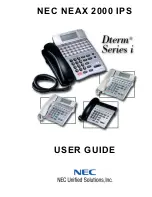
page A – 29
WheatNet-IP
/ Apr 2009
A P P E N D I C E S
WheatNet-IP
/ Feb 2013
In the WheatNet-IP Navigator GUI, locate the destination signal for fader 3 of the
control surface and right click on it and choose modify signal to get to the LIO info tab
for this signal. You will notice that there is already defined the logic function Machine
Start, among others. For future reference, you might want to make note of all of the
functions used. By the way, this information is also visible in the Details Pane. Close
the window and go back to the crosspoint grid.
Make an audio connection between the source signal “CD” (the Denon audio sig-
nal) and the destination FADER 3 on your control surface. You can use the crosspoint
grid, or use the source selector knob on the control surface; it doesn’t matter as long
as you make the connection.
Now turn on fader channel #3 and the CD player will start playing! Manually
STOP the CD player by pressing its front panel switch. Break the audio connection
between the CD player and fader 3 and make a new audio connection between “CD”
and fader #5 and turn that channel on. The CD player STARTs playing audio again,
this time over fader #5. This is the power of associated logic; a single physical con-
nection can provide transparent system-wide logic functionality.
You’ll notice that turning the fader channel OFF did not stop the Denon machine;
that’s why you had to do it manually. This is because we have only defined the Ma
-
chine Start function. We will leave the definition of the STOP function as an exercise.
Remember, each audio signal can have up to 12 associated logic functions, so there’s
plenty of room for STARTs and STOPs and ON TALLYs, etc.
Many of the logic functions needed in a typical radio environment are associated
with audio signals. You’ll find the associated logic functionality of the WheatNet‑IP
system very useful in these situations.
Logic Function definitions:
A large number of function names are defined in the
WheatNet-IP system. The functions available at the time of this writing are shown in
groups 1 through 7 below, along with descriptions of where and how they are used.
1. These functions are used with audio associated logic. The audio source they are as-
sociated with is expected to connect to a surface fader (example: E6In01), which will
have a matching pre-programmed function.
Machine Start – logic output used to start a machine, such as a CD player, when
a surface fader is turned on – by default the Machine Start function is a latched
signal, but can be made to provide a pulse by selecting the Machine Start Pulsed
VDip option for the associated audio signal in the control surface VDip settings
(see the manual for the control surface type you are using)
Machine Stop – logic output used to stop a machine, such as a CD player, when
a surface fader is turned off
Ready LED – logic input used to control the lighting of the OFF button on the
fader to advise the operator of a condition such as a CD player being cued up and
ready to play – the machine usually provides an alternating on and off signal so
that the OFF button flashes on and off
On Tally – logic output used to provide a tally of the fader’s ON button to a remote
location
















































